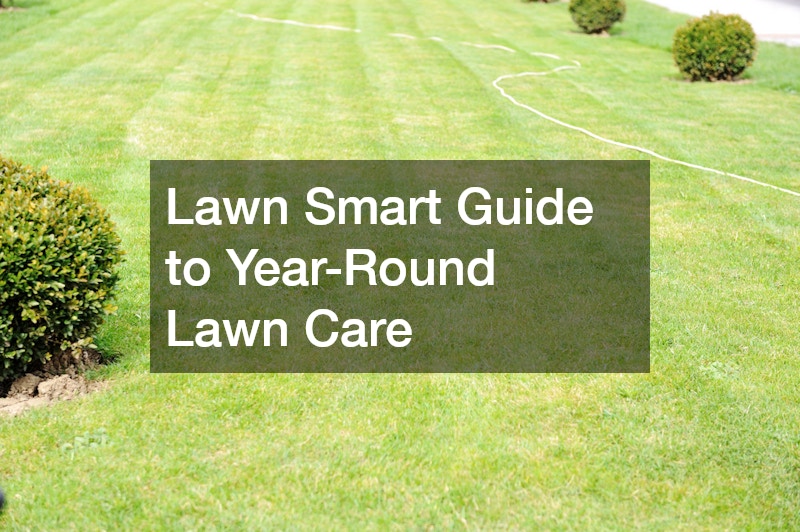Creating a beautiful and functional outdoor space requires both thoughtful design and practical planning. Today’s homeowners are increasingly drawn to landscaping approaches that adapt to changing seasons while enhancing curb appeal. With the right tools and strategies—including a lawn-smart approach to planning, planting, and layout—your outdoor areas can remain vibrant, inviting, and useful all year long. This kind of landscaping goes beyond just aesthetics; it focuses on sustainability, ease of maintenance, and the seamless integration of nature with living spaces.
A well-designed outdoor space should reflect the lifestyle and preferences of those who use it, providing areas for relaxation, entertainment, gardening, and play. This means considering everything from soil quality and sunlight patterns to water management and local climate conditions. By incorporating smart plant selection—choosing species that thrive in your specific environment—you reduce upkeep while maximizing beauty and ecological benefits. Native plants, for example, tend to require less water and fertilizer, supporting local wildlife and promoting a healthier garden ecosystem.
Hardscaping elements such as patios, walkways, retaining walls, and fire pits also add structure and functionality to your yard. These features not only create inviting spaces for social gatherings but also help manage outdoor traffic flow and reduce erosion. Thoughtful placement of these elements can emphasize focal points and enhance the overall design harmony. Moreover, integrating lighting solutions can extend the usability of your outdoor space into the evening, highlighting key features and creating a cozy ambiance.
Tree care plays a critical role in sustaining a balanced outdoor environment. Healthy trees provide shade, improve air quality, and increase property value. They also serve as natural windbreaks and privacy screens, adding comfort and security to your home’s exterior. Regular pruning, disease management, and proper watering ensure that your trees remain robust and attractive throughout the year.
Another growing trend in modern landscaping is creating seamless transitions between indoor and outdoor living areas. This can be achieved through architectural features like sliding glass doors, decks, or covered patios, which invite natural light and fresh air inside while expanding usable living space. These connections encourage a fluid lifestyle that embraces the outdoors, making your home feel larger and more integrated with its surroundings.
Ultimately, every element—from plant choice and layout to maintenance and hardscaping—plays an essential role in building a yard that feels as comfortable as it looks polished. By combining creativity with smart planning and practical knowledge, homeowners can create outdoor spaces that are not only visually stunning but also sustainable, functional, and tailored to their unique needs throughout every season of the year.
Designing a Yard That Works in Every Season
A yard that functions in every season starts with a deep understanding of your local climate and the unique environmental factors that influence plant growth and outdoor usability throughout the year. A skilled landscaping company knows that each region presents its own challenges and opportunities, from harsh winters with heavy snow and freezing temperatures to hot, dry summers or unpredictable rainy seasons. Recognizing these patterns is essential when selecting plants and features that will not only survive but thrive in your yard. A lawn-smart strategy focuses on making informed choices—selecting plants that maintain visual interest throughout the year, such as evergreens that provide vibrant green hues during the bleak winter months, or perennials that bloom in distinct cycles, offering colorful displays in spring and summer. This approach ensures your yard never feels dull or lifeless, even when some plants are dormant or less active.
The diversity in plant types—ranging from shrubs and ornamental grasses to flowering perennials and hardy groundcovers—allows for layered textures and colors that evolve with the seasons. For example, deciduous trees with vibrant autumn foliage can create breathtaking fall vistas, while flowering bulbs like tulips or daffodils add pops of color in early spring. Incorporating native plants is another wise tactic since these species are naturally adapted to your local climate, soil, and pests, reducing the need for extra watering, fertilizers, or pest control. This not only conserves resources but also supports the local ecosystem by providing habitat and food for pollinators and wildlife.
However, seasonal planting is just one component of a broader landscape design that must address practical considerations to keep your yard functional year-round. Maximizing natural light and shade through strategic plant placement and structural elements helps regulate temperatures and enhances comfort in both hot and cold seasons. For instance, deciduous trees planted on the south side of a home can provide shade in summer while allowing sunlight to warm the house during winter after they shed their leaves. Planning for snow loads or water runoff is equally important—installing proper drainage systems prevents waterlogging and erosion, while sturdy pergolas or awnings can shield seating areas from heavy snow or rain.
Low-maintenance options are also key to creating a yard that remains beautiful without demanding excessive time or resources. Drought-tolerant plants, automated irrigation systems, and mulch beds that conserve moisture reduce upkeep needs and help maintain the yard’s appeal even during busy seasons or unexpected weather changes.
Equally important is the thoughtful arrangement of pathways, sitting areas, and gathering spaces that allow for seasonal flexibility. Walkways constructed from durable, weather-resistant materials can provide safe, slip-resistant access year-round, even in icy or wet conditions. Covered patios or pergolas extend the usability of outdoor living spaces during light rain or intense sun, while portable fire pits or heaters can make cooler evenings comfortable and inviting. Designing these spaces to accommodate both quiet solitude and lively gatherings means you can enjoy your yard regardless of the weather or season, making it a true extension of your home’s living area.
Enhancing Outdoor Appeal with Durable Features
Hardscaping plays a vital role in both the structure and aesthetics of an outdoor space, serving as the foundation that shapes the overall landscape design while adding durability and functionality. A professional hardscaping service offers elements such as stone patios, brick walkways, retaining walls, and decorative edging that are not merely decorative—they help define distinct areas within your yard, creating a sense of order and flow. These features can turn an ordinary yard into an organized, inviting environment by establishing clear boundaries between garden beds, seating areas, play zones, and pathways. More importantly, hardscaping withstands the test of time much better than many soft landscaping elements, providing a stable and enduring framework that supports the growth and beauty of your plants.
A lawn-smart design carefully considers the choice of hardscaping materials to ensure they are durable and well-suited to your local climate. For example, in regions with heavy rainfall or freeze-thaw cycles, materials like natural stone or concrete pavers that resist cracking and erosion are ideal. In hotter climates, lighter-colored stones that reflect heat can help keep outdoor spaces cooler. Matching hardscaping materials to your home’s architectural style and color palette is equally important, as it creates a cohesive look that enhances curb appeal and property value. Rustic brick might complement a traditional home, while sleek concrete or metal accents can elevate a modern design. Thoughtful material selection ensures your hardscaping not only performs well but also integrates seamlessly into the overall aesthetic of your property.
Low-maintenance hardscaping is particularly valuable for homeowners with busy schedules who want to enjoy their outdoor spaces without spending excessive time on upkeep. Choosing weather-resistant materials—such as sealed stone, composite decking, or treated wood—minimizes the need for repairs or replacement over time. Additionally, functional design features like proper drainage systems, slip-resistant surfaces, and built-in seating or storage can reduce ongoing maintenance while increasing usability. Well-planned hardscaping also improves safety by providing stable, even walking surfaces and clearly defined pathways, especially important in areas prone to rain, snow, or ice.
Beyond the practical benefits, hardscaping significantly contributes to long-term property value by creating outdoor “rooms” that act as natural extensions of your home’s living areas. Patios and decks become spaces for dining and entertaining, while retaining walls and terraces can add dimension and visual interest to otherwise flat yards. These outdoor rooms expand your usable living space and enhance lifestyle possibilities, making your property more attractive to potential buyers in the future. With the right combination of durability, design, and low-maintenance features, hardscaping transforms your yard into a beautiful, functional retreat you can enjoy year-round.
Keeping Your Trees Healthy and Thriving
Adopting a lawn-smart approach means making tree care an integral part of your ongoing yard maintenance. Proper care starts with regular pruning, which helps maintain the tree’s shape, promotes healthy growth, and prevents potential hazards such as broken or dead branches. Pruning also encourages better air circulation within the canopy, reducing the risk of fungal diseases and pest infestations. Disease management is equally important, involving the identification and treatment of common tree ailments before they spread and cause significant damage. This may include applying appropriate treatments, improving soil health, or adjusting watering routines to suit the specific needs of each tree species. Additionally, thoughtful tree placement during the initial landscaping design is crucial to ensure trees have enough space to grow without interfering with buildings, power lines, or underground utilities.
Working with professionals like certified arborists or landscape designers can greatly enhance your tree care strategy. These experts can help you identify native tree species that are well adapted to your region’s climate and soil conditions. Native trees tend to be more resilient against local pests and diseases, require less water, and support indigenous wildlife better than non-native varieties. They also often provide seasonal visual interest, such as vibrant fall foliage, spring blossoms, or unique bark textures, which enrich your yard’s appearance year-round. Professionals can assess your property’s specific conditions and recommend species that will thrive while complementing your overall landscape design.
When trees are strategically placed and properly cared for, they become long-lasting anchors in your outdoor design. They create focal points, frame views, and enhance privacy, making your yard feel more intimate and inviting. Mature trees offer reliable shade during hot summer months and act as natural windbreaks in colder seasons, contributing to year-round comfort. Furthermore, well-maintained trees increase your property’s value by adding curb appeal and signaling a healthy, cared-for environment. By investing in thoughtful tree care as part of a lawn-smart landscaping approach, you cultivate an outdoor space that is not only beautiful but also sustainable and harmonious with nature. This long-term commitment to your trees ensures they remain vibrant, healthy, and beneficial for decades to come.
When and How to Remove Unwanted Trees
Sometimes trees must be removed for safety, health, or design reasons. A lawn smart strategy recognizes when a tree has outlived its purpose or presents a hazard. Tree removal services are essential for safely taking down dead or diseased trees, or those located too close to structures, to protect the integrity of the landscape.
Following removal, new planting opportunities arise. Replacing older trees with better-suited species can revitalize your yard and align it more closely with your current design goals. Making smart decisions about which trees to keep and which to replace helps maintain a balanced and attractive outdoor space.
Making Your Home and Lawn Flow as One
Seamlessly connecting your home to your yard adds value and comfort. Whole house remodels often incorporate a lawn-smart layout that includes features encouraging smooth transitions, such as large windows, covered patios, or sliding doors. These elements invite light in while allowing for a clear visual and physical flow between indoors and outdoors.
Mirroring interior styles in outdoor areas creates cohesion. Outdoor kitchens, fire pits, and lounge areas that match your home’s aesthetic can make your yard feel like a natural extension of your living space. Whether you’re remodeling or simply enhancing your backyard, thinking holistically about design ensures greater harmony.
Choosing the Right Plants for Local Conditions
Plant selection has a profound impact on the success of your landscape. Working with a local nursery can help you choose species that are suited to your soil type, water availability, and seasonal temperatures. Native plants, in particular, offer sustainability benefits while supporting local wildlife.
Smart planting also reduces maintenance. Plants that are naturally adapted to your environment require less water, fewer fertilizers, and minimal pest control. By planning for bloom cycles and color variation, your yard can offer year-round beauty with minimal effort.
Creating a Seamless Transition to the Outdoors
Porches and decks act as bridges between indoor living and the outdoor environment. A well-designed porch contributes to both comfort and curb appeal. A lawn-smart porch design incorporates safety, style, and function—think sturdy railings, wide steps, and lighting that extends usability into the evening hours. Working with an experienced porch contractor can help bring these elements together seamlessly for a polished, lasting result.
Adding decorative touches like planters, outdoor rugs, or coordinated furniture helps blur the line between indoors and out. These spaces invite relaxation and entertainment, creating multipurpose zones that feel like part of the home.
Building Spaces That Invite Relaxation
Relaxation zones add depth and functionality to your yard. Whether it’s a peaceful corner with shade trees or a full-scale patio with a fire pit, working with an experienced patio builder can help align every feature with how you plan to use the space through smart lawn design.
Comfortable seating, natural materials, and layered planting can turn even a small yard into a serene escape. Patios can be built with privacy in mind, using fencing, trellises, or tall plantings to create cozy enclosures. These details make it easier to enjoy your yard regularly, whether you’re hosting guests or simply unwinding alone.
Defining Boundaries with Style and Purpose
Fencing and landscape boundaries help organize your outdoor space. A lawn smart boundary plan takes into account privacy, property lines, safety, and aesthetics. Working with a skilled fence contractor allows you to explore options ranging from classic wood pickets to modern horizontal slats, creating boundaries that complement your design.
Incorporating fencing with natural features like hedges or climbing plants adds beauty while softening hard lines. Functional zones—such as gardens, play areas, or dog runs—can be created without compromising visual flow. Strategic layout and materials can turn a basic fence into an eye-catching design feature.
Adding Strength and Function to Your Landscape
Concrete may be one of the most versatile tools in outdoor design. From driveways and walkways to patios and planters, it offers strength, durability, and nearly endless style options. A lawn smart use of concrete includes both structural integrity and design flair.
Stamped, stained, or textured concrete can be used to replicate natural materials or add visual interest. These features create foundations for outdoor living that withstand weather and wear. Incorporating concrete in a thoughtful way increases your yard’s functionality while reducing long-term maintenance.
Adopting a lawn smart approach to outdoor design means thinking ahead, choosing wisely, and aligning features with your lifestyle and environment. From the smallest planting bed to large structural elements, every choice can contribute to a landscape that works with the seasons and reflects your personal style.
By focusing on durability, sustainability, and flow, you can create an outdoor space that offers beauty and comfort year-round. Whether you’re starting from scratch or enhancing existing features, embracing lawn smart strategies will help you build a yard that stands the test of time.


